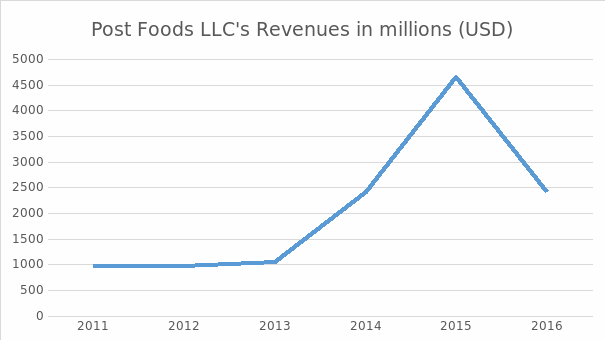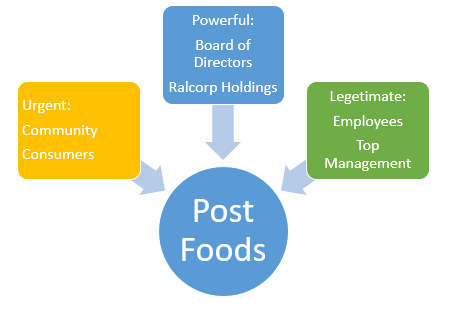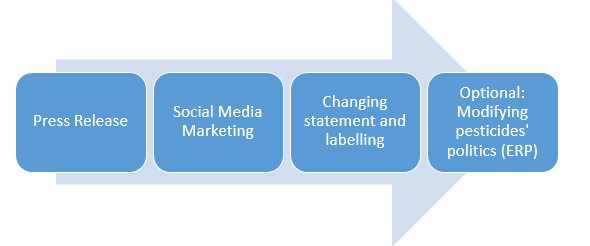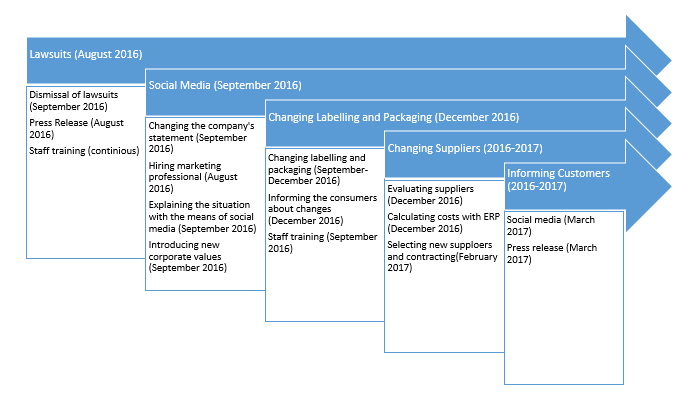Introduction
The case under discussion is an ethical dilemma that is currently challenging the Post Foods Company. According to the latest news, Post Foods has been accused of products containing glyphosate residues that are proclaimed to be “a probable human carcinogen by the Word Health Organization (WHO)” (Watson, 2016, para. 4). Nowadays, glyphosate is one of the most common pesticides used in the agriculture, and the genetically grown herbicide-tolerant dominate the current market (56%) (Benbrook, 2016).The presence of this matter raises concerns among consumers, and the usage of glyphosate interrogates Post Foods’ stated naturalness.
In this case, some experts believe that it is a vivid instance of the unethical business practices, as Post Foods’s consumers do not expect to find any pesticides in the products that are overtly advertised as ‘100% natural’ (Watson, 2016, para. 4). In other words, it is assumed that the company tries to gain profit through conducting unethical actions and deceiving its customers. Nonetheless, Post Foods is not the only market player that has faced a similar challenge. A month before the incident occurred, the production of the Quaker Company, owned by PepsiCo was likewise accused of products containing glyphosate. The company refused to take responsibility for it and explained its presence by the farmers’ irresponsible conduct (Strom, 2016).
Consequently, this paper will examine the incident and the impact it is likely to produce on the company’s performance. A particular emphasis is focused on the key triggers of the discussed event as well as the relevant consequence on the environment. Simultaneously, this paper will provide a brief overview of the company and an outline for alternative solutions and recommendations.
Company Overview
The Post Foods Company has an extended history of operations, as it was founded 100 years ago. The company specializes in producing ready-to-eat cereals that are said to be made of high-quality ingredients. The company’s target market is the USA, but it also has operations in Canada (Post Foods, 2016). Post Foods relies on the local farmers and ensures that it uses only natural ingredients.
Both aspects essentially contribute to establishing a positive, trustworthy image. The key message of the company resides in promoting healthy eating (Post Foods, 2016). Therefore, the described incident is of particular importance as it represents a critical hazard to the Post Foods’ reputation that has been created throughout a century.
Issue Identification
The so-called “triggering event” is the Post Foods Company’s decision to use glyphosate in their production and active discussion of this issue in the media. As it was initially proclaimed, the key benefit of their cereals resides in the fact that they do not contain any pesticide residues. Hence, the unethical implications are on the surface – the company has tried to convince its customers of the idea, that its products did not do any harm to health stating that they are 100% natural, even though it has concealed some important information regarding the glyphosate. These controversies were actively displayed in the media.
For instance, in magazine Law 360, Posses states that the majority of the lawsuits accuse the company in false labeling and failure to warn, as the packing did not offer any information about using pesticides in production (2016). Taking into account the active public discussion and the scope of criticism in the media, it could be concluded that the incident has had a negative impact on the company’s image and disturbed the customers’ loyalty.
In the meantime, it should be pointed out that it was only after the annual WHO’s statement in 2015 that the containment of glyphosate became considered harmful. Experts admit that its unhealthy effect has not been empirically proved yet (Lim, 2014). Nevertheless, the fact that the element is not natural is undoubted, as it is synthesized. The Federal Center states that the food, which is labeled as ‘natural’, should not contain any artificial ingredients (U.S. Food and Drug Administration, 2016).
Consequently, the key problem is that Post Foods sticks to ‘100% natural’, as it does not comply with the initial of natural provided by U.S. Food and Drug Administration mentioned above. Thus, using the slogan, ‘100% healthy,’ the company would have more chances to entrench successfully. In this case, it implies having no adverse impact on health. Despite the potential effect on kidneys and liver functioning, the unhealthy consequences have not been proven yet (Myers et al., 2016; Corporate Europe Observatory, 2016; Lim, 2014).
Simultaneously, it is not the first time that the company is accused of unethical conduct makes the situation worse. For instance, last year, the company was criticized for closing down one of its offices in Parsippany and depriving 200 employees of work (Strauss, 2015). Alternatively, in 2015, a woman filed a lawsuit for finding an alive bee in the Honey Bunches of Oats cereals by Post Foods (Marsh, 2015).
The Targeted Role
It is assumed that the discussed problem should be addressed by the company’s CEO. This position is currently held by Bart Adlam (Bloomberg, 2016). It should be noted that the president should have controlled the company’s response to the scandal in a more appropriate manner. In the context of this case study, I will take the role of the CEO and try to propose relevant solutions to improve company’s image and resolve a conflict.
According to reliable source, Post Foods’ defense attorney claimed that the ‘100% natural slogan’ should not be taken too literary, and the customers are sure to realize there is some exaggeration in it (Watson, 2016). This statement puts the company’s image under threat, and it shows that the firm’s advertising messages are initially doubtful. Additionally, the same attorney claimed that the right dosing minimized the harmful effect. However, this statement also has a negative impact on the company’s reputation, as it illustrates that Post Foods does not ensure consistent control of the ingredient dosing in its production. Moreover, this argument is irrelevant to the defense claim that accuses Post Foods of using deceiving slogans.
Targeted Question
The question to be addressed here is:
- Should Post Foods restore its reputation through excluding glyphosate from the products’ contents or admit its usage and put an emphasis on the harmlessness of this pesticide?
At the same time, it is critical to understand whether there is any chance for the company to produce its products without glyphosate. Secondly, it is important to consider the ways of reshaping its strategy.
Influence on External Factors
The primary goal of this section is to examine the significance of this incident and the consequences it is likely to cause. A particular focus is put on the social, economic, legal and other factors that are critical for the company’s performance. It is important to evaluate the associated risks and point out the affected stakeholders to outline the relevant action plan.
Social Significance
The public issue is of high social significance. The problem of pesticides is elevating in its importance in the modern society, and the mass media cannot fail to elucidate it. The public is currently divided into two groups: those who believe that glyphosate causes cancer and those who insist on its harmlessness. The issue is actively examined by two organizations, the World Health Organization (WHO) and the European Food Safety Authority (EFSA), despite the adverse effects on some organs, these organizations did not provide evidence for the fact that glyphosate is the primary causative of cancer (Corporate Europe Observatory, 2016).
Meanwhile, FDA states that ‘natural’ implies not using any artificial elements in production while a concise definition of ‘healthy[ is absent (U.S. Food and Drug Administration, 2016). The current situation might contribute to the development of new policies and definitions. Meanwhile, this issue has an adverse impact on Post Foods’ reputation and revenues.
Economic Significance
As long as the company’s customers believe that Post Foods’ advertising campaign is deceiving, they might shift to the competitors. The consumer is the most important stakeholder for being profitable, and the organization has to use “time-sensitive attitude” when working with this segment (Capon, 2008, p. 144). It should be mentioned that this shift will occur not because of the products’ quality or taste, but due to the negative connotations that the company’s reputation has acquired after the incident.
The customer outflow will essentially cause the fall of sales, and the revenues will decline. It should be noted that it is the first time that the positive dynamic of sales is disturbed. Thus, according to the company’s annual report, their net sales have been growing since 2012, reaching almost five billion dollars in 2015 (Post Foods, 2015). Thus, the situation might change in the negative direction, and Figure 1 presents a potential drop in sales shortly.

Cultural Significance
From the cultural perspective, the consumer behavior has changed significantly throughout the past decade. Thus, people have become more health-conscious; they want to know what they eat and ensure that their meals do not do any harm to their health (Mitchell & Haroun, 2016). The current incident questions whether Post Foods is able to meet customer’s expectations. Thus, not complying with this cultural change might be a potential cause of the loss of the market share.
Moral Significance
Every market player strives to enhance a good ethical and moral reputation, and Post Foods is no exception. In its annual report, the firm puts an emphasis on sustainability (Post Foods, 2015). It is needless to explain that the allegations of false advertising practice reveal the potentially unethical basis of the company’s business making methods and distorts the customers’ loyalty significantly.
Safety Significance
Despite the fact that the scientific community has not provided consistent evidence of the glyphosate’s causing cancer, the Organic Consumers Associates (OCA) claims that it is already empirically proven that the glyphosate refers to endocrine disruptors that cause numerous health-related problems (Watson, 2016). Hence, the consumption of the glyphosate-containing products is one of the potential hazards consumers’ health.
Legal Significance
From the legal standpoint, two important outcomes should be considered. Currently, the company has several lawsuits, which claim about the inconsistency of advertising (Watson, 2016). Consequently, in near future, Post Foods will receive complaints about endangering consumers’ health. In this case, it is likely to rebut the prosecution relying on the fact that there is currently no evidence of the cancer-causing effect of glyphosate offered by WHO or EFSA (Corporate Europe Observatory, 2016).
Secondly, the company can receive lawsuits associated with the false advertising. In this case, it will be more problematic to rebut the prosecution, as the company’s slogans guarantee 100% naturalness, while glyphosate is evidently a pesticide. Thus, as it was mentioned earlier, FDA that ‘natural’ can be defined as having not artificial products, but it does not contain any information about the pesticides (U.S. Food and Drug Administration, 2016). Simultaneously, it also lacks the definition of term ‘healthy’ (U.S. Food and Drug Administration, 2016). Thus, these facts can change the attitudes towards the company, as it can refer to the inconsistency of the legislation.
Conclusion
The incident is significant to the firm’s further performance. It has a negative impact on the company’s image distorting its competitive advantage in the relevant market. As a result, it can be assumed that the company’s sales might fall because of the loss of the customers’ loyalty. The incident represents a hazard to the company’s relationships with its suppliers as well. It may be concluded that the problem needs to be addressed as soon as possible to avoid severe complications.
Stakeholder Identification
Post Foods stakeholder structure has been analyzed in order to identify the key stakeholder groups. Upon the analysis, a series of stakeholders was defined:
- Board of Directors: William P. Stiritz, Jay W. Brown,
- Gregory L. Curl, David W. Kemper, Robert V. Vitale, Edwin H. Callison, Robert E. Grote, and David P. Skarie (Post Foods: Leadership, 2016).
- Management Team: Robert V. Vitale, Diedre J. Gray, Christopher J. Neugent, James E. Dwyer, Jr. Richard, R. Koulouris, and Jeff A. Zadoks (Post Foods: Leadership, 2016).; Ralcorp Holdings: are included in the shareholder list as they own 80% of the Post Foods stock (Post Foods on its own, 2012);
- Consumers: all the consumers that buy the products offered by one of the Post Foods sub-brands; Community: civil groups and environmental activists.
- Suppliers: the farming community that might be affected by the scandal (Strom, 2016); Employees: all the employees that work for Post Foods worldwide and in the USA, in particular.
Stake Identification
The table below illustrates the stakeholders’ stakes.
Table 1.Stake identification.
Summarizing the stakeholders’ interests, all the stakeholders can be divided into four groups: Finance-related stake: Board of Directors, Ralcorp Holdings, suppliers; work-related stake: management team, employees, and suppliers; health-related stake: consumers; and social change interest: community.
Stakeholder Prioritization
Option 1
In the framework of the analysis, each stakeholder has been assigned a special status. The most legitimate stakeholders are highlighted green, the most urgent stakeholders – yellow, and the most powerful – blue.
Hence, it is considered that the most legitimate stakeholders are employees and the management team. According to Capon (2008), these stakeholders demonstrate conduct that is “right, and conforms to expected and acceptable standards” (p. 144). Otherwise stated, these two groups are most likely to perform the actions that meet the interests of Post Foods.
Community and consumers are defined as the most urgent stakeholders. Therefore, it is assumed that Capon (2008) notes that such stakeholders and their needs demand a “time-sensitive” attitude (p. 144). Post Foods should address their problems first of all. Otherwise, consumers can change their behavior and turn to the company’s rivals provoking a rapid sales fall. Communities, in their turn, might further develop the scandal affecting the company’s image negatively.
The Board of Directors and Ralcorp Holdings are considered to compose the most powerful group. Capon (2008) describes this group as the one that possesses enough power and resources to “bring the outcomes they desire” (p. 144). Hence, the decision made by these groups is likely to have a diverse impact on all other stakeholders: employees, suppliers, community, customers, and management team.
Option 2
In the framework of the analysis, all the stakeholders were divided into four groups: supportive, non-supportive, marginal, and mixed-blessing.
The supportive group is represented by the management team, suppliers and the Board of Directors. These stakeholders are most likely to have a high cooperative potential. The marginal group comprises general public and Ralcorp Holdings. These stakeholders are assumed to be relatively indifferent to the company’s performance. General employees and consumers compose the mixed-blessing group as their supportiveness depends on the strategy that the corporate governance adopts. Finally, the non-supportive group includes activists as they possess a high threat potential after the discussed incident (Carroll & Buchhotz, 2014). The visual analysis of the stakeholders’ groups is represented below in Figure 2 by graphically.

Recommendations and Implications
Previously Taken Actions
One has to monitor the activities performed by the company. As it was mentioned earlier, the company was accused of failure to warn and false labeling (Posses, 2016). In the majority of the cases, the customers were reporting that Post Food’s packaging did not provide any information about pesticides (Posses, 2016). In reply to the accusations, the attorney of the company highlights the need to dismiss the case and emphasizes that there is “no reasonable consumer would understand such products will be entirely devoid of a trace of amounts of pesticides” (Watson, 2016, para. 1). Thus, he depicts the fact that the element is not dangerous in the right dosage (Watson, 2016).
In this case, it could be said that the company highlights the products comply with the recent FDA legislation, as it does not offer clear definitions of ‘natural’ and ‘healthy’. At the same time, selection the aggressive protection strategy is questionable, as the company was involved in previous lawsuits such as ‘bee’ in the Honey Bunches of Oats cereals, and this situation might damage company’s image.
Potential Actions
At the same time, it is critical to view the issue from different angles to offer a suitable framework for activities in response to the issue. In the context of the company, the proposed actions are the following:
- Continuing the legal suits and proving that the products are ‘natural’;
- Trying to prove to the consumers that the products do not have any health effects;
- Referring to the FDA and claiming the need to adjust legislation;
- Apologizing for misinformation;
- Writing posts in the social media with apology;
- Finding an alternative to glyphosate residues and using it to protect the products from insects and other plants;
- Changing the company’s mission statement about being natural and healthy entirely or partly modifying the company’s statement and sticking only to being ‘healthy’.
Based on the previous analysis of the company, following the actions such as ‘protecting its current position’ and ‘proving that the product has no effects on health’ is not reasonable for any stakeholders in the long-term. As the board of directors, Ralcorp Holdings, and the managerial team are interested in prosperity, and continuing protecting the position affects the company’s image and revenues negatively. Thus, the consumer and community are interested in reasonable price to quality ratio, and not complying with their expectation will cause the loss of the market share.
Recommendations
The company has to change its aggressive confrontation strategy to resolve a conflict by using the methods of assertiveness (McGuire, 2008; Garner, 2013). Figure 3 portrays all steps, which have to be taken by Post Foods.

The company has to post the press release to apologize for the misunderstanding and mislabeling. Thus, the company can take advantage of social media marketing to deliver the apologies and changes to the audience (Anderson, 2010).
In turn, the company has to re-design its mission statement, as it does not comply with the customers’ expectations. Making the statement less radical will minimize the conflict, as meeting customers’ expectations is a key definer of prospective client retention and satisfaction (Ferrell & Hartline, 2008). Furthermore, the company has to consider the possibility of changing to other pesticides by using ERP software.
As for the ethical obligations, complying with consumers and community’ needs is the most important aspect, as these stakeholder groups require “time-sensitive attitude” (Capon, 2008, p. 144). Thus, the apologies and mission statement will help change their attitude. Getting the support of legitimate stakeholders (management and board of directors) will ensure the connection with the customers and employees. Lastly, the organization has to highlight the importance of its employees, investors, and suppliers (Caroll & Buchholtz, 2015). Applying these practices will have a beneficial impact on the company’s internal stability and create a perception of socially responsible partner.
Costs of Implementation
To meet the consumer expectations mentioned above, the company will be required to change its business practices. One of the changes will be modifying the corporate values of Post Foods. In this case, the company has to highlight the paramount importance of meeting customers’ expectations and providing the perceived price to quality ratio. Simultaneously, the organization has to prioritize social media advertising to meet consumer expectations. Thus, reward and recognition system and KPIs can optimize the performance while taking advantage of ERP system to optimize the supply chain (Johnson, 2004; Salwan, 2014).
The required costs will have to cover consulting marketing professional (labor), attorney (labor) and changing packaging and suppliers (optional). All of the actions will require substantial investment. In this case, the approximate costs of implementation ($5-6 millions) of the recommendations will be lower than the forecasted loss in sales and market share (see Figure for timeline). Nonetheless, it has to be highlighted that the company will not withdraw from the market the previous bulks of products.

Implications
The strategies mentioned above will have an impact on the major stakeholder groups. For instance, aiming at the financial prosperity is the critical goal of the board of directors (Capon, 2008). Thus, the proposed changes would satisfy their needs, as they will reduce the expenditure on the lawsuits and minimize the influence of the conflict. Simultaneously, applying these changes has a beneficial impact on the financial prosperity of Ralcorp Holdings, as Post Foods is a critical part of the corporation.
Alternatively, employing these recommendations will have a positive impact on the decision-making initiatives of the managerial team. In this case, applying changes to the corporate values such as employee commitment and meeting customers’ expectations will positively affect internal and external communications. Thus, this aspect has a similar influence on the board of directors. As for the consumers, following these recommendations will regain their trust.
This approach assists in change attitudes of the consumers towards Post Foods. In this case, guaranteeing that the company’s statement meets customer’s expectations will shift consumer retention and satisfaction (Ferrell & Hartline, 2008). Thus, these implications will have similar implications on the community. At the same time, they might contribute to the modifications of FDA and development of the policies.
Furthermore, these changes will have a positive impact on the corporate culture of the company and employees. Simultaneously, following the recommendations provided above will also affect their financial stability in a positive direction. The rising volumes of revenues will increase company’s need in raw materials. This elevation will have an advantageous effect on their stability.
Eventually, the analysis conducted above revealed that the majority of stakeholders would satisfy their needs due to the interdependency. The satisfaction of consumers and community is highly dependent on the commitment of the employees. In turn, the managerial practices and corporate culture define the possibility to meet the goals, retain customers, and maximize revenues. Simultaneously, the organizational values and decision-making define the relationship with consumers. In this case, taking into account the interdependence of stakeholder groups in recommendations will ensure the achievement of the required goals and contribute to a positive resolution of the conflict.
References
Anderson, E. (2010). Social media marketing: Game theory and the emergence of collaboration. Portland, OR: Springer.
Benbrook, C. (2016). Trends in glyphosate use in the United States and globally. Environmental Sciences Europe, 28, 3.
Bloomberg. (2016). Company overview of Post Foods. Web.
Capon, C. (2008). Understanding strategic management. Harlow, UK: Pearson Education.
Carroll, A. B., & Buchhotz, A.K. (2014). Business and society: ethics, sustainability, and stakeholder management. New York, NY: Cengage Learning.
Corporate Europe Observatory. (2016). Glyphosate: the pesticide industry keeps the data secrecy scandal going in the name of ‘investment protection’. Web.
Ferrell, O., & Hartline, M. (2008). Marketing strategy. Mason, OH: Thompson South-Western.
Garner, E. (2013). Assertiveness: Re-claim your assertive birthright. Frederiksberg, Denmark: Ventus Publishing.
Johnson, M. (2004). The new rules of engagement: Life-work balance and employee commitment. London, UK: CIPD Publishing.
Lim, H. (2014). Is glyphosate, used with some GM crops, dangerously toxic to humans? Web.
Marsh, J. (2015). Woman went for bite of cereal, was stung by bee instead: Suit. New York Post. Web.
McGuire, J. (2008). A review of effective interventions for reducing aggression and violence. Philosophical Transitions of the Royal Society of London, 363(1503), 2577-2597.
Mitchell, D., & Haroun, L. (2016). Introduction to healthcare. Boston, MA: Cengage Learning.
Myers, J., Antoniou, M., Blumberg, B., Carroll, L., Colborn, T., Everett, L., Hansen, M.,…Benbrook, C. (2016). Concerns over use of glyphosate-based herbicides and risks associated with exposures: A consensus statement. Environmental Health, 15, 19.
Posses, S. (2016). Post Foods hit with 3 spats over ‘natural’ cereal claims. Law 360. Web.
Post Foods. (2015). Annual Report. Web.
Post Foods. (2016). Get to know more about Post Foods. Web.
Post Foods: Leadership. (2016). Web.
Post Foods on its own. (2012). Web.
Salwan, P. (2014). Best business practices for global competitiveness. New Delhi, India: Sterling Publishers Private Limited.
Strauss, E. (2015). Post Foods to shutter Parsippany HQ as part of parent’s consolidation; 200 jobs affected nationwide, NJBIZ. Web.
Strom, S. (2016). Quaker Oats’ 100% natural claim questioned in lawsuit. The New York Times. Web.
U.S. Food and Drug Administration. (2016). “Natural” on food labeling. Web.
Watson, E. (2016). Post Foods targeted in latest ‘100% natural’ lawsuit over glyphosate, Food Navigator. Web.